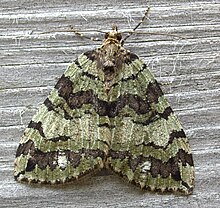Hydriomena furcata
| Hydriomena furcata | |
|---|---|

| |

| |
| Scientific classification | |
| Kingdom: | Animalia |
| Phylum: | Arthropoda |
| Class: | Insecta |
| Order: | Lepidoptera |
| Family: | Geometridae |
| Genus: | Hydriomena |
| Species: | H. furcata
|
| Binomial name | |
| Hydriomena furcata (Thunberg, 1784)
| |
| Synonyms | |
| |
Hydriomena furcata, the July highflyer, is a moth of the family Geometridae. The species was first described by Carl Peter Thunberg in 1784. It is found in the Holarctic ecozone.

Description[]
The wingspan is 23–30 mm. The ground colour ranges from green through to brown. The dark cross bands vary in intensity and pattern. There is anapical streak on the forewings. The hindwings are pale brown. It "differs from the other European species of Hydriomena in the shorter palpus, the more angled or irregular markings between the subbasal line and the median space, dark subterminal band, nearly always interrupted by a white or pale spot in the middle, absence of black vein-streaks near the apex".[1] The caterpillars are dark grey on the dorsum and ventrally dark red and with white side stripes.
The pupae are 10 to 14 millimeters long and 3 to 3.8 millimeters wide, they are reddish brown coloured and shiny. The proboscis sheath is a little shorter than the middle legs and antenna sheaths. The tenth abdominal segment is clearly curved, the labium medium in size. A safe distinction from related species is possible by means of the bristles on the cremaster
Distribution[]
It is found in Europe, the Caucasus, Transcaucasia, Urals, Kazakhstan, Siberia, Russian Far East, northern Mongolia, China, Korea, In North America, from Alaska to British Columbia and Newfoundland. It is extremely abundant in northern Europe; in central Europe it becomes more local and in the south it is apparently almost lacking; in Siberia and central Asia it has a wide range. The preferred habitat is moorland areas of sub-alpine and montane regions.

Adults are on wing from May to August. There is one generation per year.
The larvae feed on various broad-leaved trees and shrubs, including Salix and Vaccinium myrtillus.
Subspecies[]
- Hydriomena furcata furcata
- Hydriomena furcata fergusoni
References[]
- ^ Prout, L. B. 1912–16. Geometridae. In A. Seitz (ed.) The Macrolepidoptera of the World. The Palaearctic Geometridae, 4. 479 pp. Alfred Kernen, Stuttgart.
External links[]
| Wikimedia Commons has media related to Hydriomena furcata. |
- Hydriomena
- Moths described in 1784
- Geometrid moths of Great Britain
- Moths of Japan
- Moths of Europe
- Moths of Asia
- Moths of Iceland
- Taxa named by Carl Peter Thunberg
- Larentiinae stubs